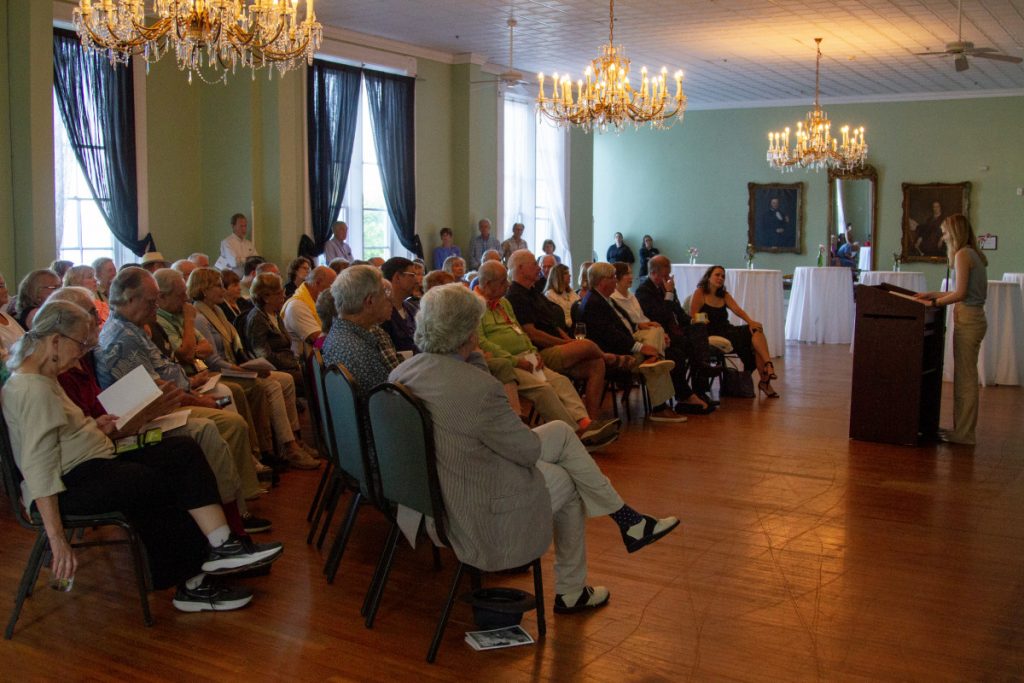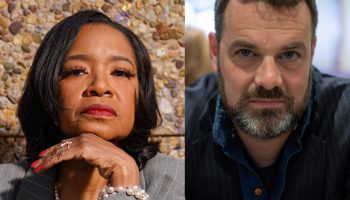
Kaitlyn Finchler
Staff writer
Named after the Roman patron, the Chautauqua Janus Prize is dedicated to an emerging writer’s single work of short fiction or nonfiction for “daring formal and aesthetic innovations that upset and reorder readers’ imaginations.”
Earlier this spring, Lily Taylor was announced as the 2023 winner for her essay “On Impressions.” She was celebrated with a reception Wednesday in the Athenaeum Hotel Parlor.
American short story and essayist Michael Martone, Week Eight’s prose writer-in-residence, served as the guest judge for this year’s Janus Prize, now in its sixth year with support from Chautauquans Twig and Barbara Branch. He selected Taylor’s work from nine finalists.
“The title of the piece caught me, as it is about catching one’s eye,” Martone said. “The essay expertly exerts pressure on the word ‘impressionism.’ … The essay works like the Impressionist paintings in regard to suggestion, nuance, juxtaposition and collage.”
He said the essay, which is available at the CLSC Octagon, allows and encourages collaboration between the writer and reader — something that isn’t seen often. He described it as “complex, layered, ethereal and concrete,” while simultaneously being “microscopic, multidimensional and brilliant.”
Taylor said she was overwhelmed in the short time she had on the grounds before the Janus Prize presentation. Chautauqua’s commitment to fostering a place to celebrate art is a “rare and beautiful” experience, she said, since she’s from a generation she feels doesn’t appreciate art the way she wishes they did.

“Years ago, I saw a blog post from the Poetry Foundation titled, ‘The average fourth-grader is a better poet than you, and me too,’ ” Taylor said. “Intrigued (and) maybe a little bit insulted, I read the article.”
She gave examples from the article of fourth-graders’ poetry, and asked how a 9-year-old could write better than adults. The blog’s author answered by saying children are better at writing about “sadness, death, love, age, responsibility, family, loneliness and revenue” because they haven’t been alive long enough to know how to talk about the world in any way other than at face value.
“I’m sure many of you have heard the saying: ‘Writers can only bring 50% of meaning to their work and that readers bring the other 50%,’ ” Taylor said. “I would argue that (for) the lyric essay, that’s not quite accurate.”
In her graduate studies, Taylor’s class was visited by Elena Passarello, director of Oregon State’s MFA program, who addressed the tension of a lyric essay between reader and writer.
“The lyric essay functions to try and bridge the gap between author and reader, accepting the chasm that inherently separates the two,” Taylor said. “What does this mean? We’re testing freedom, both a gift and a burden.”
Creative nonfiction, Passarello said, is desperate and no better than “lipstick on a pig.”
“Many believe the difference between creative nonfiction and poetry is that creative nonfiction is grounded in facts, and it concerns accurately representing real events,” Taylor said. “In cases of poetry, it’s more concerned about artistic expression and often employs figurative language and symbolism to convey meaning.”
However, the beauty of a lyric essay, she said, is “the marriage” of both creative nonfiction and poetry. When she started writing “On Impressions,” she was in her second semester of graduate school and the only instruction from the professor was for it to be braided, meaning three or more distinct topics intertwined together.
“As I wrote this way, I learned to spot connections between seemingly disparate ideas,” Taylor said. “I realized that it’s through the shifts in theme and tone that the essay comes to reveal something deeper than what I’ve written on the page.”
Whenever a classmate asked her for advice on their own essays, Taylor would say, “find the bruises.” By pressing down on physical and metaphorical bruises, she said people might be surprised by how much it does or doesn’t hurt to touch.
“I discovered that I was covered in bruises,” she said. “Some of the metaphorical fresh shades of blue and green, or older browns and yellow that only I could see. Others were real; the remnants of cosmetic procedures I’d undertaken.”
This is where she began “On Impressions.” She started asking herself why she chose to inflict pain on herself, to give herself bruises she didn’t need to have. The answer wasn’t clear at the time.
For the second braid of the essay, she chose artwork from the Impressionists, as she was already a fan of Monet’s work. As she worked on the essay, Taylor said she found herself trying to force a connection between herself and Monet’s art.
When Taylor received notice she was a finalist for the Janus Prize, her professor said he was thrilled, but she had no chance of winning because her essay was “not that weird,” and she agreed.
She then quoted work from James Baldwin’s writing about the patriarchy and writing for the “old white man,” when she found herself in front of a “terrible” realization.
“It was not a white man who I wrote for,” Taylor said. “My answer seems much more narcissistic, and in some ways terrifying: I wrote for myself.”
Since “On Impressions” was originally only for a class assignment — and she didn’t think anyone other than she and her professor would see it — she said it gave her more mental freedom to write how she’d like.
“I was unencumbered by trying to write what might make sense,” Taylor said. “I wrote chaotically short transit statements (and) long-winded paragraphs. … So why did this work? I can only think of one answer: the power of emotional truth.”
Women, she said, are subjected to infantilization and gaslighting in a culture that only cares about physical appearance and the benefits of a patriarchy.
“I built a working miniature replica of patriarchy in my mind,” Taylor said. “I would very much like to bust it up or burn it down, but I’m afraid I don’t know how.”
This desire to be beautiful and conform to society goes back to ancient times. She compared writing a lyric essay to building a sandcastle. Despite the message from the title, it isn’t about the dangers or virtues of creative nonfiction, hoping something “might finally” stick.
“This is about the beautiful game of breadth of this immutable literary form,” Taylor said. “Our nomenclature – law-eliminating, polarizing, inadequate and always stupid – can also be the thing that opens up our chakras to hostilities in the past.”
She said her work has now entered brains that are not her own, and those who will process her words aren’t just her professor.
“I challenge all of us here to build sandcastles,” she said. “Build high and wide, and destroy them. Or better yet, find a fourth-grader in you. … Learn to love the feeling of scrubbing yourself raw or exposing them to care.”




